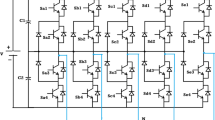Abstract
In this paper, three phase four wire five level Neutral Point Clamped Inverter (NPCI) based Static synchronous Compensator (STATCOM) is implemented for reactive power control and neutral current elimination. Three dimensional Space Vector Pulse Width Modulation (3D-SVPWM) control strategy is developed to control this 5-level NPC inverter. The behaviour of static synchronous compensator is analyzed and reactive power control is done using constant DC voltage. The objective of this compensating method is to provide balanced and sinusoidal source currents under unbalanced and nonlinear load conditions and reactive power control. The 3D-SVPWM technique provides reduced harmonic content in output voltage and current, controlled source current, minimized common mode voltage and improved output voltage. In 3D-SVPWM, switching pulses are generated with non-redundant switching states, which lead to reduce the complexity in switching time calculation and computational time is less. The highlights of the paper includes the neutral current is reduced to 0.25A, source current harmonics is minimized and it provides balanced and sinusoidal source currents with help of STATCOM compensation. The simulation and experimental results demonstrates the sinusoidal and harmonics free source current and minimized neutral current for four wire five level NPCI based STATCOM.






















source current for various methods 3D-SVPWM & 2D-SVPWM
Similar content being viewed by others
References
Iyer S, Ghosh A, Joshi A (2005) Inverter topologies for DSTATCOM Applications- a simulation study. Elect. Power Syst Res 75(2–3):161–170
Rodriguez J, Lai J, Pengo FZ (2002) Multilevel inverters: a survey topologies, controls, and applications. IEEE Trans Ind Electron 49(4):724–738
Lai JS, Pengo FZ (1996) Multilevel converters - A new breed of power converters. IEEE Trans Ind Applicat 32(3):509–517
Nabae A, Takahashi L, Akagi H (1981) A new neutral-point clamped PWM inverter. IEEE Trans Ind Appl IA-17(5):518–523
Naresh K. Kummari, Asheesh K. Singh and Pradeep Kumar, Comparative Evaluation of DSTATCOM Control Algorithms for Load Compensation. Proceedings of IEEE Harmonics and power quality j power (lCHQP) 2012.
Pichan M, Rastegar H, Monfared M (2017) Deadbeat control of the stand-alone four-leg inverter considering the effect of the neutral line inductor. IEEE Trans Ind Electron 64(4):2592–2601
Miveh MR, Rahmat MF, Ghadimi AA, Mustafa MW (2018) Control techniques for three-phase four-leg voltage source inverters in autonomous microgrids: A review. Renew Sustain Energy Rev 54:1592–1610
Palanisamy R, Vijayakumar K (2020) SVPWM control strategy for a three phase five level dual inverter fed open-end winding induction motor. ISA Trans 102:105–116. https://doi.org/10.1016/j.isatra.2020.02.034
Shukla A, Ghosh A, Joshi A (2011) Hysteresis modulation of multilevel inverters. IEEE Trans Power Electron 26(5):1396–1409
E. Heydari, M. P. Moghaddam and A. Y. Varjani, Multi-resonant dual loop control of stand-alone four-leg inverter for microgrids applications, Proceedings on 9th Annual Power Electronic Drives System Technology Conference (PEDSTC), pp. 352–357, Feb. 2018.
A. Abllan, G. Garcera, M. Pascual, and E. Figueres, A new current controller applied to four-branch inverter shunt active filters with UPF control method, Proceedingd of PESC’ 01, Vol. 3, 2001, pp. 1402–1407.
N. Geddada, S. B. Karanki, M. K. Mishra, and B. K. Kumar, Modified four leg DSTATCOM topology for compensation of unbalanced and nonlinear loads in three phase four wire system, Proceedings of EPE 11, 2011, pp. 1-10
Tanaka H, Ikeda F, Tanaka T, Yamada H, Okamoto M (2016) “Novel reactive power control strategy based on constant dc-capacitor voltage control for reducing the capacity of smart charger for electric vehicles on single-phase three-wire distribution feeders. IEEE J Emerg Sel Top Power Electron 4(2):481–488
Chandrasekaran G et al (2020) Test Scheduling of System-on-Chip Using Dragonfly and Ant Lion Optimization Algorithms. J Intell Fuzzy Syst. https://doi.org/10.3233/JIFS-201691L
N. Arruda, S. M. Silva, and B. J. C Filho, PLL structure for utility connected systems, In: Conf. Rec. of the 36th IEEE-IAS Annu. Meet., Chicago, USA, 2001, pp. 2655–2660.
Kondo R, Akagi H (2008) Voltage-balancing control of three-level PWM converter in a transformerless hybrid active filter. IEEJ Trans on Ind Appl 128(12):1388–1395
Chandrasekaran G, Periyasamy S, Panjappagounder Rajamanickam K (2020) Minimization of test time in system on chip using artificial intelligence-based test scheduling techniques. Neural Comput Appl 32:5303–5312. https://doi.org/10.1007/s00521-019-04039-6
Zhang W, Ding C (2018) Mitigation of the low-frequency neutral-point current for three-level t-type inverters in three-phase four-wire systems. IET Power Electron 11(8):1444–1451
Jiang D, Wang F (2013) Variable Switching Frequency PWM for Three-Phase Converters Based on Current Ripple Prediction. IEEE Trans Power Electron 28(11):4951–4961
Palanisamy R, Shanmugasundaram V, Vidyasagar S et al (2020) A SVPWM Control Strategy for Capacitor Voltage Balancing of Flying Capacitor Based 4-Level NPC Inverter. J Electr Eng Technol. https://doi.org/10.1007/s42835-020-00533-3
Lin Z, Ruan X, Jia L et al (2019) Optimized design of the neutral inductor and filter inductors in three-phase four-wire inverter with split dc-link capacitors. IEEE Trans Power Electron 34(1):247–262
Shuai Z, Xiao M, Ge J et al (2019) “Overcurrent and its restraining method of pq-controlled three-phase four-wire converter under asymmetrical grid fault”, IEEE. J Emerging Sel Topics Power Electron 7(3):2057–2069
Avci E, Ucar M (2018) SRF based output voltage control of 3-level 3-phase 4-leg AT-NPC inverter. J Polytech 21:961–966
Miveh MR, Rahmat MF, Ghadimi AA, Mustafa MW (2016) Control techniques for three-phase four-leg voltage source inverters in autonomous microgrids: A review. Renew Sustain Energy Rev 54:1592–1610
Ramasamy P, Krishnasamy V (2017) A 3D-space vector modulation algorithm for three phase four wire neutral point clamped inverter systems as power quality compensator. Energies 10(11):1792
Author information
Authors and Affiliations
Corresponding author
Additional information
Publisher's Note
Springer Nature remains neutral with regard to jurisdictional claims in published maps and institutional affiliations.
Rights and permissions
About this article
Cite this article
Palanisamy, R., Karthikeyan, D., Vidyasagar, S. et al. Reactive Power Control and Neutral Current Elimination of Four Wire Five Level NPC Inverter based STATCOM using 3D-SVPWM Technique. J. Electr. Eng. Technol. 16, 2083–2097 (2021). https://doi.org/10.1007/s42835-021-00738-0
Received:
Revised:
Accepted:
Published:
Issue Date:
DOI: https://doi.org/10.1007/s42835-021-00738-0




